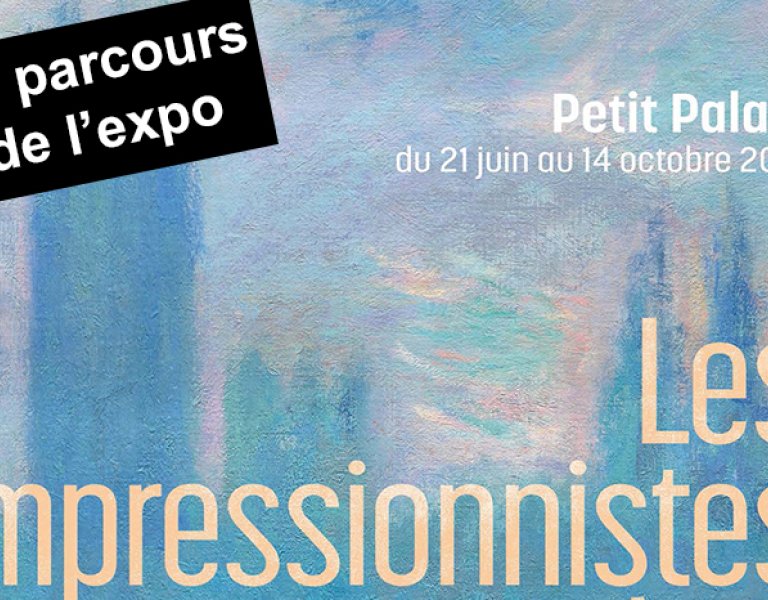
Les Impressionnistes à Londres / Impressionists in London: the layout of the exhibition
Before visiting the exhibition Les Impressionnistes à Londres / Impressionists in London, which is on until 14 October 2018 at the Petit Palais, check out the layout of the exhibition and read the story of these artists who fled to Britain to escape war in France.
Museum
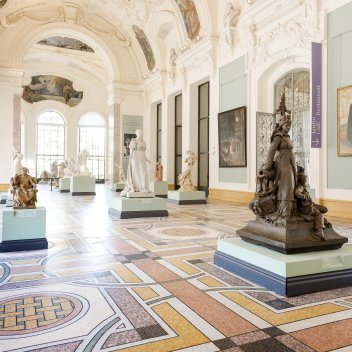
Avenue Winston Churchill
75008 Paris
France
After the Franco-Prussian war and insurrection in Paris, a number of French artists sought refuge across the Channel in London. Notable among them were Monet, Pissarro, Sisley, Tissot and Legros.
In spite of their social and political differences and their diverse artistic sensibilities, these artists became a fascinating community of exiles.
The exhibition Les Impressionnistes à Londres / Impressionists in London follows the work of these French artists exiled in London chronologically. It is at the Petit Palais until 14 October 2018.
An opportunity here for a brief preview of their time in London, which not only influenced their own work, but also contributed to the British art scene.
Room 1: 1870-1871: Paris at war, Paris in ruins

© Musée Carnavalet / Roger-Viollet
Jean-Baptiste-Camille Corot (1796-1875), Le Rêve.
The exhibition Les Impressionnistes à Londres / Impressionists in London begins with the reasons why these artists came to London: France's defeat in the Franco-Prussian War of 1870.
A brief historical reminder: in spite of the French Emperor's surrender after defeat at Sedan, fighting continued until the Prussian army attacked Paris on 19 September 1870, beginning the Siege of Paris. For several months, the population was subjected to a war of waiting, exacerbated by the rigours of a cold winter, lack of food and bombardments.
The armistice was signed on 26 February 1871 and Germany annexed Alsace and part of Lorraine. An intolerable decision for Parisians who rose up against the French government. The Paris Commune was proclaimed.
In May 1871, the government armies put an end to this insurrection in Paris: there were no less than 20,000 victims and major monuments were burned down. This became known as "Bloody Week".
This room presents a series of works to shed light on this difficult episode in the history of Paris.
Room 2: Arrival in London

© Courtesy of Museum of Art, Rhode Island School of design, Providence
Claude Monet, Hyde Park, 1871, huile sur toile. Museum of Art, Rhode Island School of design, Providence, don de Mrs Murray S. Danforth. Photographie par Erik Gould.
After a digital presentation, based on Claude Monet's "Seascape, Night Effect", which depicts crossing the English Channel, this room recounts the arrival of French artists in London.
London was a huge city whose population was growing at a phenomenal rate. This growth was largely due to the migration of workers from all over England and Ireland: the capital had become the largest industrial centre in Europe. Victorian England offered an attractive refuge to exiles arriving from France for economic or political reasons. Freedom of opinion, independence of the press and the absence of customs controls meant that any foreigner could travel to England and settle there. Its geographical proximity to France and the economic role of the British Empire made London an ideal base.
Claude Monet was thirty-one years old when War was declared, he reached London in mid-September 1870.
Room 3: The community of future impressionists
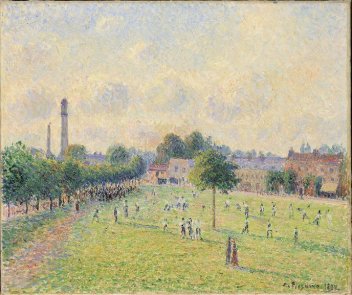
© Lyon, MBA - Studio Alain Basset
Camille Pissarro, Kew Green, 1892, huile sur toile, Musée d’Orsay, Paris, en dépôt au musée des Beaux-Arts de Lyon, legs de Clément et Andrée Adès, 1979.
This third room presents works by Monet, Pissarro and Daubigny, three artists in the circle of future Impressionists.
With its thriving art market, London was an attractive destination for artists in exile. The landscape painter Charles-François Daubigny met Paul Durand-Ruel who had opened a gallery on New Bond Street. His gallery became a base for promoting French painting, especially the Barbizon school.
Monet arrived in the autumn of 1870 but painted only six views of London parks and the Thames. His works were deemed too out-of-step with the English art scene; they were not what the English art market was looking for and, in spite of encouragement from Daubigny, Monet was disheartened and left London in 1871.
Camille Pissarro joined up with some close relatives in London where he used to frequent the French quarter between Soho and Leicester Square. He married his wife on June 14, 1871.
Room 4: The economic exile of Carpeaux

© Calouste Gulbenkian Foundation, Lisbonne. Photo : Carlos Azevedo
Jean-Baptiste Carpeaux, Flore, 1873, Museu Calouste Gulbenkian, Founder’s Collection, Lisbonne.
This fourth room presents works by Jean-Baptiste Carpeaux, who fled the hardships of the siege of Paris to find refuge in England, from March to December 1871.
The sculptor sought new commissions by exhibiting each year at the Royal Academy and by being involved in sales at Christie's. Carpeaux also made sculptures of famous artists, French friends who, like him, were in exile (Jean-Léon Gérôme and the composer Charles Gounod); he also sculpted portraits of English commissioners of art like Lord Ashburton or Henry James Turner - the patron of Gérôme and Tissot.
Room 5: James Tissot, anglophile

© Tate 2018. Photo : Lucy Dawkins et Samuel Cole
James Tissot, La Galerie du «HMS Calcutta» (Portsmouth), vers 1876, huile sur toile, Tate, Londres, don de Samuel Courtaud en 1936.
This 5th room presents works by James Tissot (1836-1902), dandy and painter of city life, whose first name was actually Jacques Joseph. He lived in England for eleven years and was highly successful.
The paintings he did in England show how Tissot adapted his style to suit a public that was fond of genre scenes.
His meticulous representations of contemporary life offer a nuanced and slightly ironic view of England's social rituals.
As a painter of city life, Tissot attached great importance to fashion and the complex rules of etiquette dictated by high society.
His commercial popularity continued after he returned to France in 1882.
Room 6 : Alphonse Legros, un peintre au cœur de la communaut
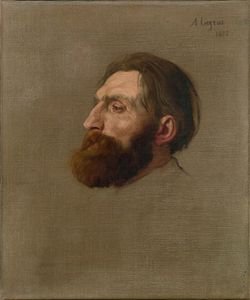
© Musée Rodin
Alphonse Legros, Portrait d’Auguste Rodin, 1882, huile sur toile, Musée Rodin, Paris.
This first section of the sixth room presents a few works by Alphonse Legros. Legros had already moved to London before the war; he went there in 1863 for economic reasons, after taking advice from Whistler.
He made friends with the pre-Raphaelite painters Rossetti, Watts and Burne-Jones and became the most important contact for his French compatriots after 1870, including Monet, Pissarro and Tissot, who he introduced to his English network. Legros also helped Dalou and Rodin to get a foothold in the London market.
He became a teacher at the South Kensington School of Art, then at the Slade School of Fine Art, where he taught drawing, painting engraving and modelling.
Jules Dalou: the art of modelling
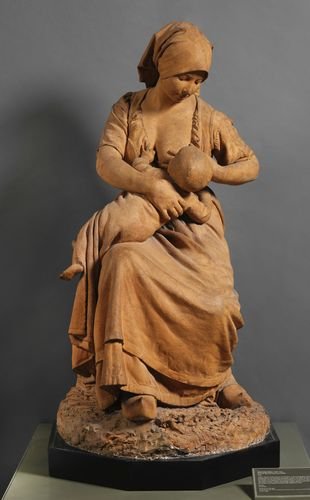
© Victoria and Albert Museum, Londres
Jules Dalou, Paysanne française allaitant, 1873, terre cuite.
The second section focuses on the career of the sculptor and former communard Jules Dalou, who was forced to move to London for a period of eight years.
Warmly welcomed by his English counterparts, Jules Dalou exhibited a terracotta statuette, Le Jour des rameaux in Boulogne (Palm Sunday in Boulogne), at the Royal Academy in 1872. It was the first of a series of highly successful works.
The subjects that Dalou modelled usually involved intimate matters. His clients saw him as an artist in the tradition of 18th century French sculptors. His mastery of modelling, and the combination of realism and charm that characterised his English works, influenced a whole generation of students.
Room 7: Portraits of each other
The portraits in this room are the result of exchanges between artists. They testify to the support networks that bound them together during their time in London, most notably Legros, who made his network available to many French artists in exile.
Or the art dealer Paul Durand-Ruel who had his own network of gallery owners and clients in London and who championed French painters in his exhibitions of the Society of French Artists.
There is also an interactive map of London in this room showing the places depicted by the French artists in exile in England.
Room 8: Pissarro and Sisley

© National Galleries of Scotland. Photo : Antonia Reeve
Alfred Sisley, Le Barrage de Molesey, Hampton Court, effet du matin, 1874, huile sur toile, Scottish National Gallery, Edimbourg.
This eighth room shows various works depicting the English landscape as seen by the painters Pissarro and Sisley.
Pissarro, Sisley and Monet were featured in the Parisian exhibition at which the term "impressionist" was coined, a word that was used by proponents of the smooth style of painting advocated by the French academic masters.
Their stays in London were instrumental in encouraging the Impressionists to work outside (en plein air). The places they tended to choose were those that new city dwellers went to for leisure and recreation.
Room 9: Monet and the Thames

© The Art Institute of Chicago
Claude Monet, Le Parlement de Londres, vers 1900-1901, huile sur toile. The Art Institute, Chicago. Mr and Mrs Martin A. Ryerson Collection.
This 9th room features the series of views of the Houses of Parliament that Monet painted from the window of his room in the Savoy Hotel.
Monet first painted Westminister Palace in 1871. In 1900, the year he turned sixty, Monet had an urge to revisit subjects on which he had previously worked "to recapture in one canvas, sometimes two, the impressions and feelings [he] had had in the past.
Maintaining the same point of view from one canvas to another, the artist strove to capture the infinite variations of that very distinctive light where the river and the sky meet.
Room 10: Derain in London, a homage and a challenge
In this last room we can admire the tribute that the fauve painter André Derain paid to Monet by choosing the same motifs on the banks of the Thames, while at the same time challenging the work of his master.
He wrote to Maurice de Vlaminck about these views of the Thames: "In spite of everything, I adore him, perhaps even because of his misguidedness, which is a precious lesson to me. But when all is said and done, is he not right to render the natural impression, with its fleeting, impermanent colour, which is in fact only an impression? I was looking for something else, for that which, on the contrary, is fixed, eternal, and complex in nature.”
He had challenged his master by developing his own expressiveness and in his turn presenting a radically new image of London.
Exhibition Les Impressionnistes à Londres / Impressionists in London
At the Petit Palais, 21 June – 14 October 2018
Avenue Winston Churchill 75008 Paris